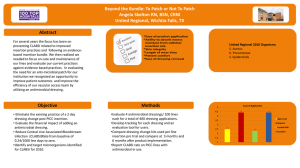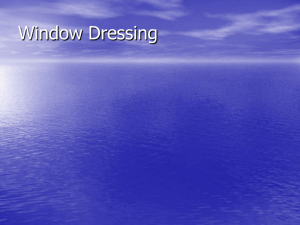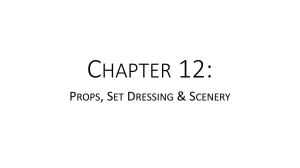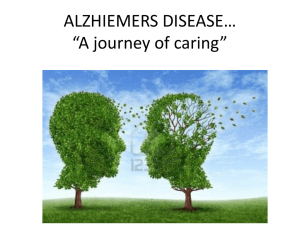Dressing Application
advertisement
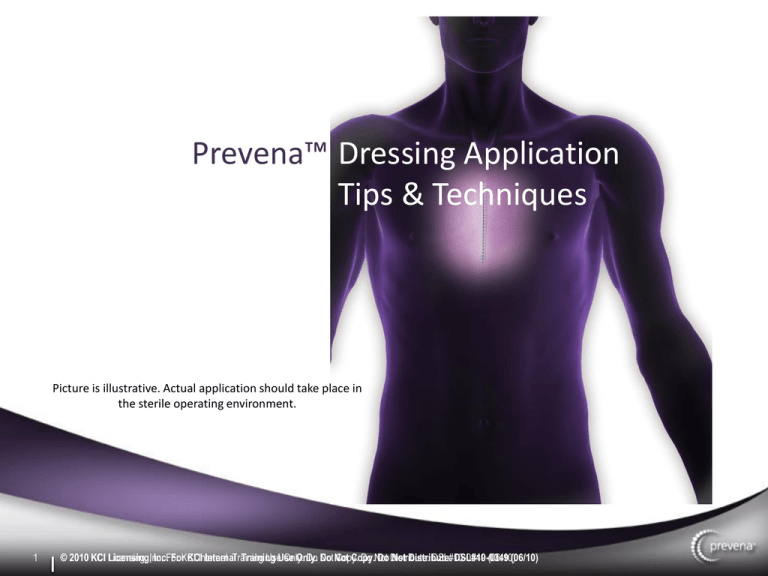
Prevena™ Dressing Application Q2 Marketing Tips Update & Techniques Amy Torrecillas Picture is illustrative. Actual application should take place in the sterile operating environment. 1 © 2010 KCI Licensing, UseUse Only. Do Not Copy. Do Not DSL#10-0349 (06/10)(06/10) Licensing,Inc. Inc.For ForKCI KCIInternal InternalTraining Training Only. Do Not Copy. Do Distribute. Not Distribute. DSL#10-0349 Prevena™ Incision Management System Indication The Prevena™ Incision Management System is intended to manage the environment of surgical incisions that continue to drain following sutured or stapled closure by maintaining a closed environment and removing exudate via the application of negative pressure wound therapy. 2 © 2010 KCI Licensing, Inc. For KCI Internal Training Use Only. Do Not Copy. Do Not Distribute. DSL#10-0349 (06/10) n l y . D o N o t C o p y . D o N o t D i s t r i b u t e . D S L # 1 0 0 3 4 9 ( 0 6 / Prevena™ Incision Management System Contraindication and Warnings CONTRAINDICATION: Sensitivity to silver. WARNINGS • Bleeding: Before applying the Prevena™ Incision Management System to patients who are at risk of bleeding complications due to the operative procedure or concomitant therapies and / or co-morbidities, ensure that hemostasis has been achieved and all tissue planes have been approximated. If active bleeding develops suddenly or in large amounts during therapy, or if frank blood is seen in the tubing or in the canister, the patient should leave the Prevena™ Incision Dressing in place, turn off Prevena™ 125 Therapy Unit and seek immediate emergency medical assistance. • Infected Wounds: As with any wound treatment, clinicians and patients / caregivers should frequently monitor the patient’s wound, periwound tissue and exudate for signs of infection, or other complications. Some signs of infection are fever, tenderness, redness, swelling, itching, rash, increased warmth in the wound or periwound area, prulent discharge, or strong odor. Infection can be serious, and can lead to complications such as pain, discomfort, fever, gangrene, toxic shock, septic shock and/or fatal injury. Some signs or complications of systemic infection are nausea, vomiting, diarrhea, headache, dizziness, fainting, sore throat with swelling of the mucus membranes, disorientation, high fever, refractory and / or orthostatic hypotension, or erythroderma (a sunburn-like rash). Silver in the interface layer of the Prevena™ Incision Dressing is not intended to treat infection, but to reduce bacterial colonization in the fabric. If infection develops, Prevena™ Therapy should be discontinued until the infection is treated. • Allergic Response: The Prevena™ Incision Dressing has an acrylic adhesive coating and a skin interface layer with silver, which may present a risk of an adverse reaction in patients who are allergic or hypersensitive to acrylic adhesives or silver. If a patient has a known allergy or hypersensitivity to these materials, do not use the Prevena™ Incision Management System. If any signs of allergic reaction, irritation or hypersensitivity develop, such as redness, swelling, rash, urticaria, or significant pruritus, patient should consult a physician immediately. If bronchospasm or more serious signs of allergic reaction appear, the patient should turn off the therapy unit and seek immediate emergency medical assistance. 3 © 2010 KCI Licensing, Inc. For KCI Internal Training Use Only. Do Not Copy. Do Not Distribute. DSL#10-0349 (06/10) Prevena™ Incision Management System Warnings (contd.) 4 • Defibrillation: Remove the Prevena™ Incision Dressing if defibrillation is required in the area of dressing placement. Failure to remove the dressing may inhibit transmission of electrical energy and / or patient resuscitation. • Magnetic Resonance Imaging (MRI): The Prevena™ 125 Therapy Unit is MR Unsafe. Do not take the Prevena™ 125 Therapy Unit into the MR environment. The Prevena™ Incision Dressing can typically remain on the patient with minimal risk in an MR environment. Interruption of Prevena™ Therapy during MRI may reduce the effectiveness of Prevena™ Therapy. The Prevena™ Incision Dressing should pose no known hazards in an MR environment with the following conditions of use: static magnetic field of 3 Tesla or less, spatial gradient field of 720 Gauss/cm or less, and maximum whole-body-averaged specific absorption rate (SAR) of 3W/kg for 15 minutes of scanning. • Diagnostic Imaging: The Prevena™ Incision Dressing contains metallic silver that may impair visualization with certain imaging modalities. • Hyperbaric Oxygen Therapy (HBO): Do not take the Prevena™ 125 Therapy Unit or Prevena™ Incision Dressing into a hyperbaric oxygen chamber; it is not designed for this environment, and should be considered a fire hazard. If Prevena™ Therapy is reinitiated after HBO treatment, do not readhere the same dressing, a new dressing must be applied. • Canister Full: If at any time while using the Prevena™ Incision Management System, the canister becomes full of fluid other than blood, indicated by a Maximum Capacity Alert or visual inspection, the patient should turn therapy unit off and contact the treating physician. © 2010 KCI Licensing, Inc. For KCI Internal Training Use Only. Do Not Copy. Do Not Distribute. DSL#10-0349 (06/10) Prevena™ Incision Management System Precautions 5 • Standard Precautions: To reduce the risk of transmission of bloodborne pathogens, apply standard precautions for infection control with all patients, per institutional protocol, regardless of their diagnosis or presumed infection status. In addition to gloves, use gown and goggles if exposure to body fluid is likely. • Circumferential Dressing Application: Avoid applying the Prevena™ Incision Dressing circumferentially. In cases where the clinician determines that the benefits of applying the Prevena™ Incision Dressing circumferentially outweighs the risk of circulatory compromise, extreme care should be taken not to stretch or pull the dressing when securing it. Attach the dressing loosely and stabilize edges with an elastic wrap if necessary. It is crucial to systematically and recurrently palpate distal pulses and assess distal circulatory status. If circulatory compromise is suspected, discontinue therapy and remove dressing. • Electrodes or Conductive Gel: Do not allow the Prevena™ Incision Dressing to come in contact with EKG or other electrodes or conductive gels during electronic monitoring or when taking electronic measurements. • Dressing Components: The Prevena™ Incision Dressing contains ionic silver (0.019%). Application of products containing silver may cause temporary tissue discoloration. • Always use Prevena™ dressings and canisters from sterile packages that have not been opened or damaged. • All components of the Prevena™ Incision Management System are for single use only. Do not re-use any component of this system. • To avoid trauma to the skin, do not pull or stretch the adhesive border of the dressing during application.. © 2010 KCI Licensing, Inc. For KCI Internal Training Use Only. Do Not Copy. Do Not Distribute. DSL#10-0349 (06/10) Introduction The purpose of this presentation is to provide an overview of the Prevena™ Incision Dressing application and to specifically highlight features of the Prevena™ System that will assist you in training customers and facilitate product use. This presentation uses several pictures to illustrate application techniques. Pictures are provided as examples only and are not intended to indicate appropriate time of product placement or recommend procedure types appropriate for this product. The treating physician should direct specific application and treatment protocols for individual patients. Refer to Clinician Guide for specific set-up and application including additional information 6 © 2010 KCI Licensing, Inc. For KCI Internal Training Use Only. Do Not Copy. Do Not Distribute. DSL#10-0349 (06/10) System Overview Prevena™ 125 Therapy Unit and Prevena™ Carrying Case (non-sterile) • Pre-programmed -125mmHg negative pressure • Battery powered by three AA Batteries • Carrying Case included to facilitate patient mobility Prevena™ 45mL Canister (sterile) • Contains up to 45mL of fluid • Omni-directional (works in any orientation) Prevena™ Incision Dressing and Prevena™ Patch Strips (sterile) • • • • 7 Peel and Place Application Wicking skin interface layer Built–in Pressure Indicator Patch Strips used to help seal dressing leaks © 2010 KCI Licensing, Inc. For KCI Internal Training Use Only. Do Not Copy. Do Not Distribute. DSL#10-0349 (06/10) Dressing Application Sequence 1. 2. 3. Apply dressing over clean, closed incision Connect dressing to canister, insert canister into device Power on Ensure all dressing leaks are resolved by utilizing the VisiCheck™ Feature The VisiCheck™ Feature will be discussed later in this presentation. During this presentation, the terms “dressing” and “dressing area” are used interchangeably and refer to the skin area covered by both the foam and drape shown in purple on this picture Illustration of basic application. Please consult the Prevena™ Incision Management System “Clinician Guide” for detailed information on product use and application. 8 © 2010 KCI Licensing, Inc. For KCI Internal Training Use Only. Do Not Copy. Do Not Distribute. DSL#10-0349 (06/10) Application Technique The following slides provide application tips that should help prevent the user from encountering unnecessary alerts and annoyance. Proper application of Prevena™ Incision Dressing is critical to prevent leak alerts during placement. Proper and quick response to leaks is important to help ensure batteries last through completion of therapy. For this reason, the Prevena™ System is very sensitive, even to micro leaks. Note: Because of the smaller size and disposable nature of this product, it cannot compensate for the same level of air leaks around the dressing as existing V.A.C.® Therapy Units. Care should be taken to minimize leak paths during placement to help promote optimal therapy. 9 © 2010 KCI Licensing, Inc. For KCI Internal Training Use Only. Do Not Copy. Do Not Distribute. DSL#10-0349 (06/10) Prior to Surgery • Ensure necessary materials to support Prevena™ Incision Management System are present: – Prevena™ Incision Management System – Materials to clean and dry skin prior to dressing placement, including skin prep, such as Cavilon or Mastisol (optional) – Back-up Prevena™ Incision Dressing, if desired • • Ensure surgeon understands where percutaneous drains or wires, if used, should exit the skin relative to the outside perimeter of the Prevena™ Incision Dressing. Surgeon may close as he or she normally would, using sutures or staples. Ask the question. – If surgeon uses a liquid skin adhesive to close, such as DERMABOND®, have a discussion with the surgeon. – Surgical adhesives are not contraindicated with Prevena. However, if used, it will prevent one of the functions of the dressing, which is to pull moisture and edema from the incision line. • Reminder, the Prevena™ Incision Management System is intended to be placed immediately post surgery while still in the sterile environment. 10 © 2010 KCI Licensing, Inc. For KCI Internal Training Use Only. Do Not Copy. Do Not Distribute. DSL#10-0349 (06/10) Skin Preparation Prior to Surgery Prior to surgery, shave or clip the surgical area where the dressing will be applied* Leak path caused by applying a dressing over hair Note: Failure to shave or clip the surgical area will cause the hair to lay down on itself creating a leak pathway from the inside of the dressing to atmosphere. This could lead to leak alerts immediately after dressing application *Follow facility protocols for surgical prep 11 © 2010 KCI Licensing, Inc. For KCI Internal Training Use Only. Do Not Copy. Do Not Distribute. DSL#10-0349 (06/10) Planning For Dressing Application Prior to Surgery • Consider the dressing location so the dressing is placed over intact skin. • The dressing is NOT to be cut or manipulated. Note: Cutting the dressing may lead to creation of a leak path. This might lead to leak alerts. 12 © 2010 KCI Licensing, Inc. For KCI Internal Training Use Only. Do Not Copy. Do Not Distribute. DSL#10-0349 (06/10) Planning For Dressing Application Prior to Surgery Surgical drains must be routed under the skin beyond the boundary of the dressing and function independently of the Prevena™ Incision Management System Do NOT place drains under the dressing area Note: Routing a drain through or under the dressing adhesive will cause a leak pathway from the inside of the dressing to atmosphere. This could lead to leak alerts immediately after dressing application. Dressing Adhesive Foam Drain Tube Skin Surface Leak path caused by applying a dressing over a drain 13 © 2010 KCI Licensing, Inc. For KCI Internal Training Use Only. Do Not Copy. Do Not Distribute. DSL#10-0349 (06/10) Early Tips for Success • Drains under the dressing • Wires under the dressing • Unclipped hair under the dressing • Cutting the dressing • Peeking under the dressing NOTE: These conditions can lead to the creation of a leak path. This could lead to leak alerts. 14 © 2010 KCI Licensing, Inc. For KCI Internal Training Use Only. Do Not Copy. Do Not Distribute. DSL#10-0349 (06/10) Skin Preparation After Surgery After surgery, all residual surgical skin prep should be removed from area where the dressing will be applied prior to adhering the dressing to the skin. Water, saline, alcohol, or similar solution should be used to wipe surgical prep from the skin. Note: Failure to remove surgical skin prep may cause interference between the drape and the skin and cause the drape to lift during application. This can lead to leak alerts. No need to remove surgical skin prep on the incision itself. 15 © 2010 KCI Licensing, Inc. For KCI Internal Training Use Only. Do Not Copy. Do Not Distribute. DSL#10-0349 (06/10) Skin Preparation After Surgery • Dry the skin where the dressing will be applied prior to adhering the dressing. • Ensure there is no adhesive tape or gauze or any other foreign material under the planned dressing area. • Use skin prep, such as Cavilon or Mastisol, on the area surrounding the incision where the dressing is to be applied. Note: Attempting to apply the dressing on wet skin will damage the adhesive and cause the dressing not to stick. 16 © 2010 KCI Licensing, Inc. For KCI Internal Training Use Only. Do Not Copy. Do Not Distribute. DSL#10-0349 (06/10) Dressing Application & Initiating Therapy 1. The dressing is designed to be applied in stages – Align the foam portion of the dressing over the incision line. Decide on direction of the tubing. • If part of the incision is longer than the dressing, cover the exposed portion with a non-adherent layer, such as Adaptic, so it does not come into contact with the adhesive in the Tegaderm. – Tacking the top and bottom edges of the dressing first will help reduce wrinkling. • If skin has wrinkles or folds, smooth out the skin as the dressing is being applied. • The dressing should always go IN the skin folds, NOT on top of folds, to avoid creating a leak path. – Remove the two remaining bottom adhesive covers, pressing on the skin as the cover is removed. • Keeping a small amount of tension on the drape will also help prevent it from wrinkling. • Smooth out the dressing perimeter as you apply it. – Press firmly around the dressing and foam border to ensure a good seal – Once the dressing is appropriately adhered, remove the top stabilization layers • Hold the drape down on the skin as you remove the paper stabilization layers on the top of the dressing. 2. Connect the luer locks from the tubing on the dressing to the tubing on the canister. 3. Insert the canister into the Prevena 125 Therapy Unit, and slide inward until canister clicks. Canister is fully inserted when the side tabs are flush with the body of the therapy unit. 4. Initiate therapy by pressing and holding the ON/OFF button for 2 seconds; an audible beep will confirm that therapy is on. A green LED on the front of the unit indicates that therapy is on. 5. Once the dressing draws down, utilize the VisiCheck™ Feature to check the integrity of the seal. The patient should leave the OR once a one-light “best” seal is achieved. 17 © 2010 KCI Licensing, Inc. For KCI Internal Training Use Only. Do Not Copy. Do Not Distribute. DSL#10-0349 (06/10) Check Dressing Seal Integrity After applying Prevena™ Incision Dressing, ALWAYS check the seal integrity using the VisiCheck™ Feature. This feature is displayed by double pressing the On/Off Button. Note: The VisiCheck™ Feature should be used after every dressing application. Failure to ensure there is a proper seal at the time of application may results in leak alerts. 18 © 2010 KCI Licensing, Inc. For KCI Internal Training Use Only. Do Not Copy. Do Not Distribute. DSL#10-0349 (06/10) Tips for Best Practices • Upon application of the Prevena dressing and assembly of Therapy Unit, attach the strap to the Prevena carrying case and insert the Therapy Unit. • Fold the Patient Brochure with your KCI business card and insert it in the cover of the carrying case, so it always goes with the patient. This way, the patient or nurses may call you with questions regarding troubleshooting. • Put the Prevena Clinician’s Guide into the patient’s chart for reference. • Stop by post-op recovery. Leave a business card with the patient’s assigned nurse in case questions arise. Find out where the patient will end up in the hospital. Inservice the floor nurses and leave a card. • When appropriate, inservice patient’s family members on the Prevena dressing, showering protocols (if patient going home), and basic troubleshooting. Instruct them to set up an appointment to have the dressing removed in 7 days. Remind them your card and Patient Brochure are in the carrying case. • Round on patient at least once before discharge. Ensure everything is going smoothly with the therapy. Perform one last VisiCheck™ before the patient goes home. 19 © 2010 KCI Licensing, Inc. For KCI Internal Training Use Only. Do Not Copy. Do Not Distribute. DSL#10-0349 (06/10) Troubleshooting a Leak • Press firmly around the perimeter of the dressing to ensure it is fully adhered to the skin. • Look for large wrinkles in the dressing. If you spot a larger wrinkle extending to the perimeter of the dressing, seal it with a patch strip. • Look for skin folds under the dressing. If you spot a fold extending to the perimeter of the dressing, seal it with a patch strip. You may also utilize wound care supplies, such as moldable strip paste. • If there are drains or gauze underneath the dressing, it may be necessary to isolate them depending on their location. If they do not interrupt the foam border of the dressing, use Tegaderm to isolate. • Check that the canister is fully inserted by listening for the canister clicks. You may verify the canister is fully inserted by ensuring the side tabs are flush with the body of the therapy unit. • Check that all connectors are tightly engaged. If in doubt, disconnect and re-connect connectors. • Utilize the VisiCheck™ Feature as you troubleshoot a leak, in order to confirm the leak has been successfully resolved. Note: The Prevena™ Pressure Indicator is designed to collapse at -75mmHg. It is NOT a leak indicator and should not be used for troubleshooting a leak. 20 © 2010 KCI Licensing, Inc. For KCI Internal Training Use Only. Do Not Copy. Do Not Distribute. DSL#10-0349 (06/10) Troubleshooting a Leak • If unable to resolve leak following troubleshooting, decide your next course of action: –Discuss whether or not to discontinue Prevena Therapy. If necessary, contact physician to discuss options. –Change out Prevena dressing on the floor using sterile technique by instructing the floor nurse or WOCN. –If dealing with a high-risk incision line, assess whether it is prudent to disturb the dressing. Consider leaving Prevena dressing in place and connecting to a V.A.C.® Therapy Unit. •.If the decision is made to leave Prevena dressing in place, connect Prevena dressing to V.A.C. ® Therapy Unit. This should be done as a last resort… –Using sterile technique, detach base of Prevena tubing using sterile scissors. –Lay down a piece of V.A.C.® drape over the exposed foam in the dressing. –Cut a quarter-sized hole in the V.A.C.® drape and attach the V.A.C.® TRAC Pad on top. –If dealing with two Prevena dressings side by side, use a Y-connector. –Connect tubing to V.A.C.® Therapy Unit. 21 © 2010 KCI Licensing, Inc. For KCI Internal Training Use Only. Do Not Copy. Do Not Distribute. DSL#10-0349 (06/10) Dressing Removal • Upon completion of therapy, dressing should be removed in line with the incision • Use adhesive remover if dressing is sticking to the patient or in a hard-to-reach area • Best Practice Tips: –Confirm 7-day follow-up appointment with the physician’s office to make sure patient has the dressing removed before completion of Prevena therapy. –Offer to attend dressing removal with physicians to support the doctor and obtain clinical feedback. –Bring adhesive remover wipes or spray. 22 © 2010 KCI Licensing, Inc. For KCI Internal Training Use Only. Do Not Copy. Do Not Distribute. DSL#10-0349 (06/10) Application Tips Summary Skin Preparation – Shave or clip the surgical area where the dressing will be applied, according to the facility’s protocols on skin preparation – Instruct surgeon to route drains and/or wires outside the perimeter of the dressing – Make sure to isolate any gauze or tape that may be in the area of the dressing – Remove residual surgical prep from area where dressing adhesive will be applied – Dry the skin where the dressing adhesive will be applied – Apply skin prep, such as Cavilon or Mastisol, to area surrounding the incision line (optional) 23 © 2010 KCI Licensing, Inc. For KCI Internal Training Use Only. Do Not Copy. Do Not Distribute. DSL#10-0349 (06/10) Application Tips Summary Dressing Application – Drains and wires should exit the skin outside of the dressing perimeter – Tacking the top and bottom edges of the dressing first helps reduce wrinkling – Keeping a small amount of tension on the drape during application helps prevent it from wrinkling – Dressing should go IN any skin folds, NOT on top of skin folds – Hold the drape down on the skin as you remove the paper stabilization layers on top of the dressing – After applying the dressing, always check seal integrity using the VisiCheck™ Feature – The dressing should NOT be cut or manipulated 24 © 2010 KCI Licensing, Inc. For KCI Internal Training Use Only. Do Not Copy. Do Not Distribute. DSL#10-0349 (06/10) Application Tips Summary Troubleshooting a Leak – Press firmly around perimeter of the dressing to ensure it is fully adhered to the skin – Patch any wrinkles or folds extending to the perimeter of the dressing using extra patch strips (included with Prevena kit) – If additional patching is needed, utilize wound care supplies, such as extra Tegaderm strips or strip paste – In case of improper placement of drains or gauze, attempt to isolate – Understand long-term unresolved leaks run batteries down sooner than the 7-day therapy period. Battery replacement may be necessary (lithium batteries preferred). – Utilize VisiCheck™ Feature throughout troubleshooting to confirm leak has been resolved 25 © 2010 KCI Licensing, Inc. For KCI Internal Training Use Only. Do Not Copy. Do Not Distribute. DSL#10-0349 (06/10) THANK YOU!!! All trademarks designated herein are proprietary to KCI Licensing, Inc., its affiliates and/or licensors. 26 © 2010 KCI Licensing, Inc. For KCI Internal Training Use Only. Do Not Copy. Do Not Distribute. DSL#10-0349 (06/10)




